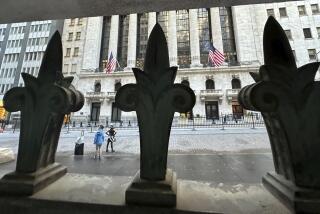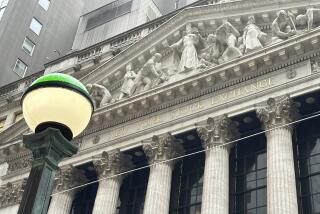Bond investors face a reckoning as interest rates jump
- Share via
Wall Street has preferred to call the recent rebound in long-term interest rates a “wake-up call.”
But to some bond investors it’s apparently more like a five-alarm fire.
As rising interest rates have pushed down the value of older bonds in the last two months, the share prices of popular bond mutual funds have slumped.
Case in point: Shares of the Pimco Total Return Bond fund have dropped 6.4% since May 2.
The losses aren’t on the scale of what happened to stocks in 2008-09, when that market plunged nearly 50% in six months. But after years of viewing bonds as a haven, investors suddenly are reconsidering.
Some are fleeing. Investors yanked $9.9 billion from the Pimco fund in June, or about 3.5% of assets.
Outflows have rocked other bond funds as well. In turn, that has left remaining investors wondering whether the sellers are prescient sentinels or just panicked lemmings.
What troubles many bond owners isn’t the rise in interest rates so far, but the risk that the U.S. could be facing a sustained uptrend.
An entire generation of Americans has only known falling rates: Long-term bond yields have mostly been declining for 30 years — which means the value of bond portfolios has mostly been rising for that long.
Over the last 14 years, the average taxable bond fund has had positive total returns every year except 2008. And money has poured in: Total U.S. bond fund assets have nearly tripled since 2004, to $3.47 trillion.
Now what? Here’s a primer to help bond investors understand the market’s recent gyrations and how to evaluate the potential risks and rewards of owning fixed-income securities.
Why have interest rates risen, and why does that make existing bonds fall in value?
The Federal Reserve began warning in mid-May that if the U.S. economy continued to improve the central bank probably would reduce its regular purchases of Treasury and mortgage bonds. Those purchases, ongoing since 2008, have helped keep a lid on long-term interest rates in general.
Some investors and traders reacted by quickly dumping bonds, betting that higher interest rates were inevitable. The selling has driven the yield on the benchmark 10-year Treasury note from 1.63% in early May to 2.74% now. That has pushed up other long-term rates as well, such as on corporate and municipal bonds.
As yields on new bonds rise, the value of most existing bonds falls. The simple reason: If new bonds yield, say, 2.7%, no investor would pay full price for an older bond that yields, say, 2%. So the market price of the older bond must decline, at least initially.
Could interest rates really be in a long-term uptrend now?
If you believe that U.S. and foreign economies will be in better shape a few years from now, it would make sense that rates should rise from current generational lows.
“I think we’re in the foothills of a secular rise in interest rates,” said Dan Fuss, who has managed money since 1958 and heads the $22-billion Loomis Sayles Bond Fund in Boston.
Bill Gross, who manages the Pimco Total Return bond fund in Newport Beach, agrees that interest rates have seen their lows. But he believes that the latest jump in bond yields has been overdone given the U.S. economy’s modest growth rate.
“Don’t jump ship now,” Gross implored investors in a late-June written commentary.
Why did bond yields surge, if all the Fed did was say that it might reduce its bond purchases at some point?
The sell-off highlighted one of the risks posed by the surge of money into bonds since 2008: Inevitably, some of those bond owners will try to “front-run” the Fed and a turn in interest rates. Once selling begins, it can quickly snowball.
“Millions of people think they can get out the door at once,” said Tad Rivelle, chief investment officer for bonds at TCW Group in Los Angeles.
The last month was a warning of how volatile the bond market could become.
Does that mean that long-term interest rates could rise dramatically from current levels?
That’s possible. But for yields to then stay elevated would most likely require a continuing barrage of strong economic data, or rising inflation, or both.
What’s more, the Fed said last month that even if it began to cut back on bond purchases it would be in no hurry to raise its key short-term interest rate. That rate, lately about 0.1%, in effect anchors all other U.S. interest rates.
Jeffrey Gundlach, head of DoubleLine Capital in Los Angeles, told investors in a late-June conference call that he expected Treasury bond yields to fall again between now and year-end. Given rock-bottom short-term rates and low inflation, bond yields have already “risen to a point where the values are pretty compelling,” he said.
But if I expect interest rates to gradually move higher over the next few years, why be in bonds at all now?
First, if you’re wrong you could miss out on another rally in bonds.
If the economy sinks again, interest rates could quickly retreat. High-quality, fixed-rate bonds would probably again become a favored haven.
Second, even if rising market rates depress older bonds’ values, you’re still earning interest along the way.
That’s why bond funds typically are judged by “total return” — meaning the net change in the share price, plus interest earned.
In the first half of this year the Pimco Total Return fund’s share price fell 4.3%. But that was partly offset by interest earnings. So shareholders’ net loss was 3%.
Even if bonds become more volatile, they’re still likely to be less volatile than stocks over time.
If I own individual bonds and intend to hold them until they mature, should I care about short-term price swings?
If you hold an individual bond until it matures you will get back the full face value of the security when it was issued, assuming the issuer has the money to repay. And along the way you’ll continue to earn the bond’s fixed rate of interest.
Kate Mead, a 65-year-old Santa Barbara retiree, has a portfolio of individual municipal bonds that will mature in a “laddered” sequence over time. She said she has no worries about leaving the portfolio be. “I hold everything very long-term,” she said.
And if interest rates rise on new bonds, all the better, Mead said. Her portfolio now is about 50% bonds and 50% stocks, but she expects to tilt more toward bonds as she gets older, she said.
What about bond mutual funds — isn’t the risk of loss open-ended, because the portfolios never mature?
It’s true that funds don’t have a set maturity. Rather, the portfolio of bonds changes as the fund manager buys and sells. So the daily price of a fund’s shares reflects changes in the underlying bonds’ market values, and there’s no guarantee of getting your principal back in full.
But fund managers may have the ability to buy higher-yielding bonds if market interest rates rise, eventually boosting your interest earnings. With an individual bond, by contrast, your yield is fixed.
Loomis Sayles’ Fuss, for example, said he had very little invested in U.S. Treasury bonds but expected to add more high-yielding corporate and emerging-market bonds to his fund if interest rates continued to move up.
How can an investor reduce the risk of bond devaluation in a time of rising interest rates?
The easiest way is to own bonds with relatively short-term maturities. For example, if market rates rise, a bond maturing in two years will decline less than a bond maturing in five years. That’s simply because your money will come back to you sooner with the shorter-term bond.
But owning shorter-term bonds means you’ll earn less interest income, because those securities pay less than longer-term securities. So you’re trading yield for less volatility.
A two-year T-note now pays just 0.4% in annual interest, compared with 3.7% for a 30-year T-bond.
How can I tell how much risk my bond fund faces from rising rates?
Every bond fund owner should know their fund’s “duration.” Duration gives a rough estimate of a bond fund’s sensitivity to changes in interest rates.
“Duration gives you a sense of what kind of shock risk you have” from changing rates, said Eric Jacobson, bond fund analyst at Morningstar in Chicago.
To estimate the change in a fund’s share price under different interest-rate scenarios, multiply the duration figure by the expected change in market rates. For example, if interest rates rise one percentage point, a fund with a duration of three would see its share price fall about 3%, while a fund with a duration of six would be expected to lose about 6%.
The Loomis Sayles fund’s current duration is about 4.7. The Metropolitan West Total Return Bond fund, managed by TCW’s Rivelle, has a duration of about 4.3. Gundlach’s DoubleLine Total Return Bond fund is 3.2.
But investors can’t rely on duration alone, Jacobson notes. Bond fund owners should know what kinds of bonds a fund owns and the manager’s strategy, he said.
Autopilot worked fine for many bond investors over the last 30 years. But it’s time to switch it off.
More to Read
Inside the business of entertainment
The Wide Shot brings you news, analysis and insights on everything from streaming wars to production — and what it all means for the future.
You may occasionally receive promotional content from the Los Angeles Times.










